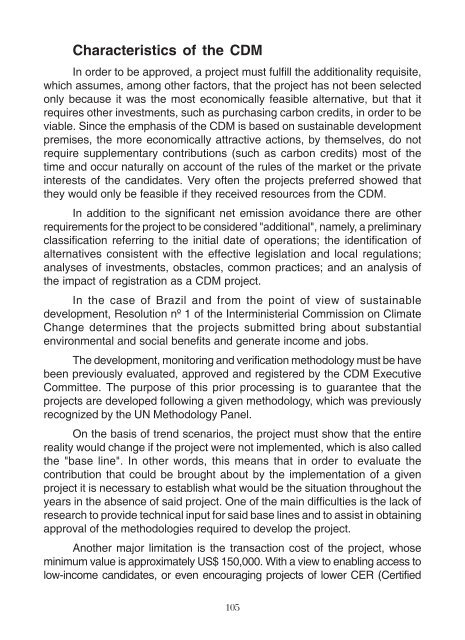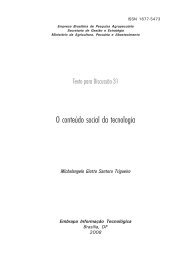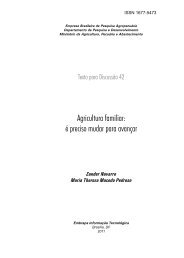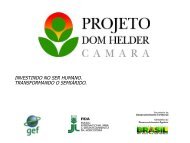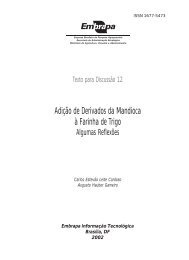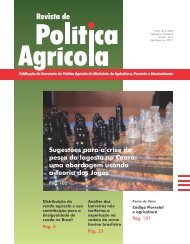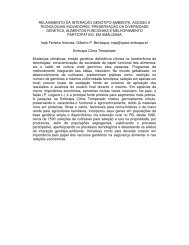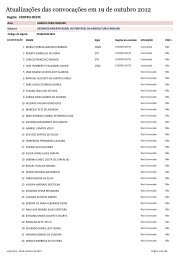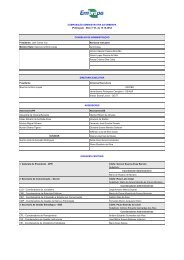Ministry of Agriculture, Livestock and Food Supply - Embrapa
Ministry of Agriculture, Livestock and Food Supply - Embrapa
Ministry of Agriculture, Livestock and Food Supply - Embrapa
Create successful ePaper yourself
Turn your PDF publications into a flip-book with our unique Google optimized e-Paper software.
Characteristics <strong>of</strong> the CDM<br />
In order to be approved, a project must fulfill the additionality requisite,<br />
which assumes, among other factors, that the project has not been selected<br />
only because it was the most economically feasible alternative, but that it<br />
requires other investments, such as purchasing carbon credits, in order to be<br />
viable. Since the emphasis <strong>of</strong> the CDM is based on sustainable development<br />
premises, the more economically attractive actions, by themselves, do not<br />
require supplementary contributions (such as carbon credits) most <strong>of</strong> the<br />
time <strong>and</strong> occur naturally on account <strong>of</strong> the rules <strong>of</strong> the market or the private<br />
interests <strong>of</strong> the c<strong>and</strong>idates. Very <strong>of</strong>ten the projects preferred showed that<br />
they would only be feasible if they received resources from the CDM.<br />
In addition to the significant net emission avoidance there are other<br />
requirements for the project to be considered "additional", namely, a preliminary<br />
classification referring to the initial date <strong>of</strong> operations; the identification <strong>of</strong><br />
alternatives consistent with the effective legislation <strong>and</strong> local regulations;<br />
analyses <strong>of</strong> investments, obstacles, common practices; <strong>and</strong> an analysis <strong>of</strong><br />
the impact <strong>of</strong> registration as a CDM project.<br />
In the case <strong>of</strong> Brazil <strong>and</strong> from the point <strong>of</strong> view <strong>of</strong> sustainable<br />
development, Resolution nº 1 <strong>of</strong> the Interministerial Commission on Climate<br />
Change determines that the projects submitted bring about substantial<br />
environmental <strong>and</strong> social benefits <strong>and</strong> generate income <strong>and</strong> jobs.<br />
The development, monitoring <strong>and</strong> verification methodology must be have<br />
been previously evaluated, approved <strong>and</strong> registered by the CDM Executive<br />
Committee. The purpose <strong>of</strong> this prior processing is to guarantee that the<br />
projects are developed following a given methodology, which was previously<br />
recognized by the UN Methodology Panel.<br />
On the basis <strong>of</strong> trend scenarios, the project must show that the entire<br />
reality would change if the project were not implemented, which is also called<br />
the "base line". In other words, this means that in order to evaluate the<br />
contribution that could be brought about by the implementation <strong>of</strong> a given<br />
project it is necessary to establish what would be the situation throughout the<br />
years in the absence <strong>of</strong> said project. One <strong>of</strong> the main difficulties is the lack <strong>of</strong><br />
research to provide technical input for said base lines <strong>and</strong> to assist in obtaining<br />
approval <strong>of</strong> the methodologies required to develop the project.<br />
Another major limitation is the transaction cost <strong>of</strong> the project, whose<br />
minimum value is approximately US$ 150,000. With a view to enabling access to<br />
low-income c<strong>and</strong>idates, or even encouraging projects <strong>of</strong> lower CER (Certified<br />
105


